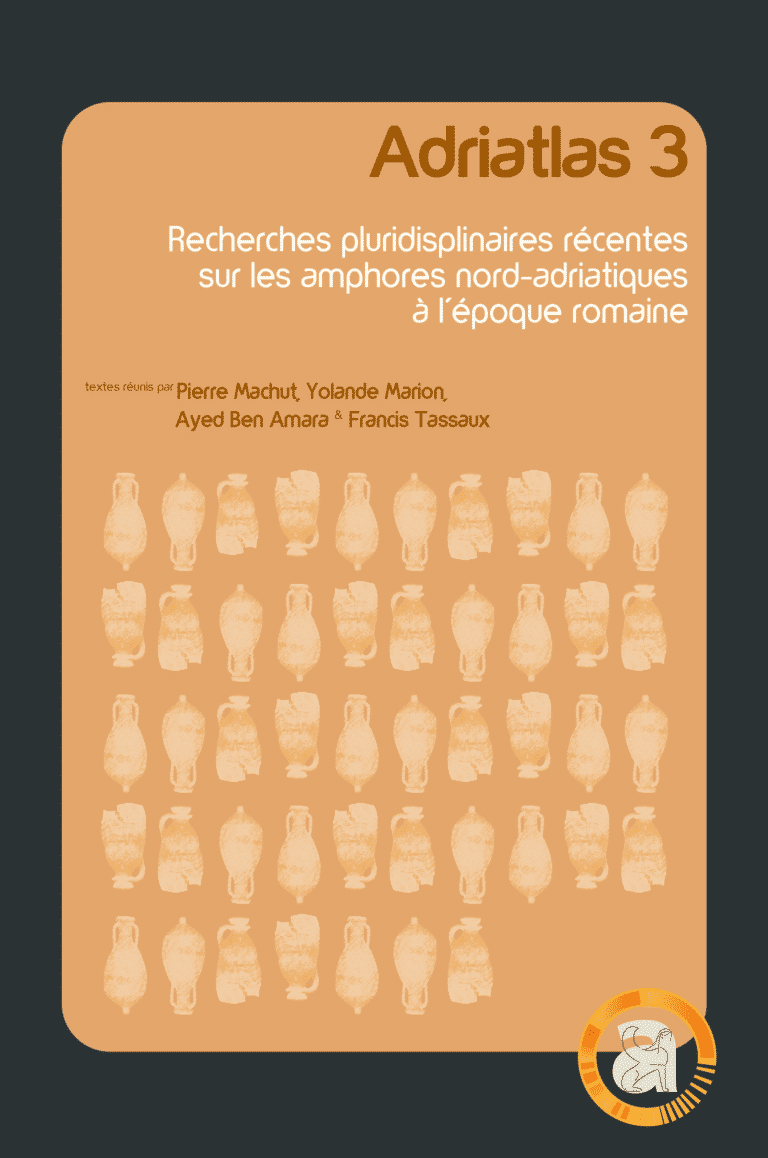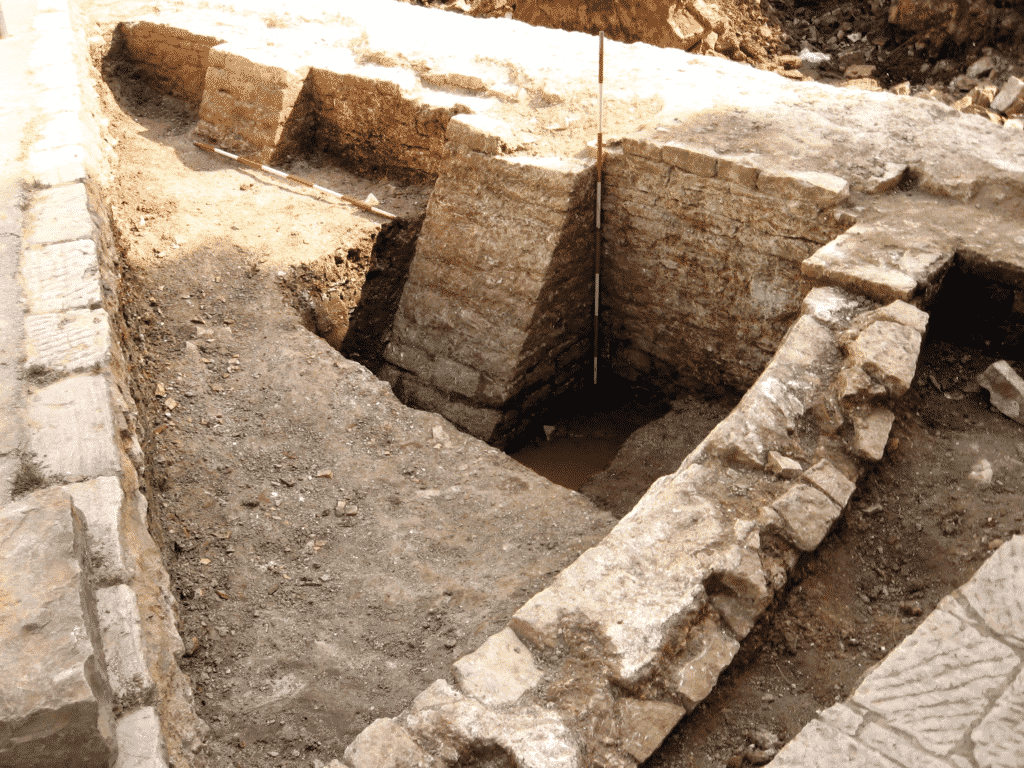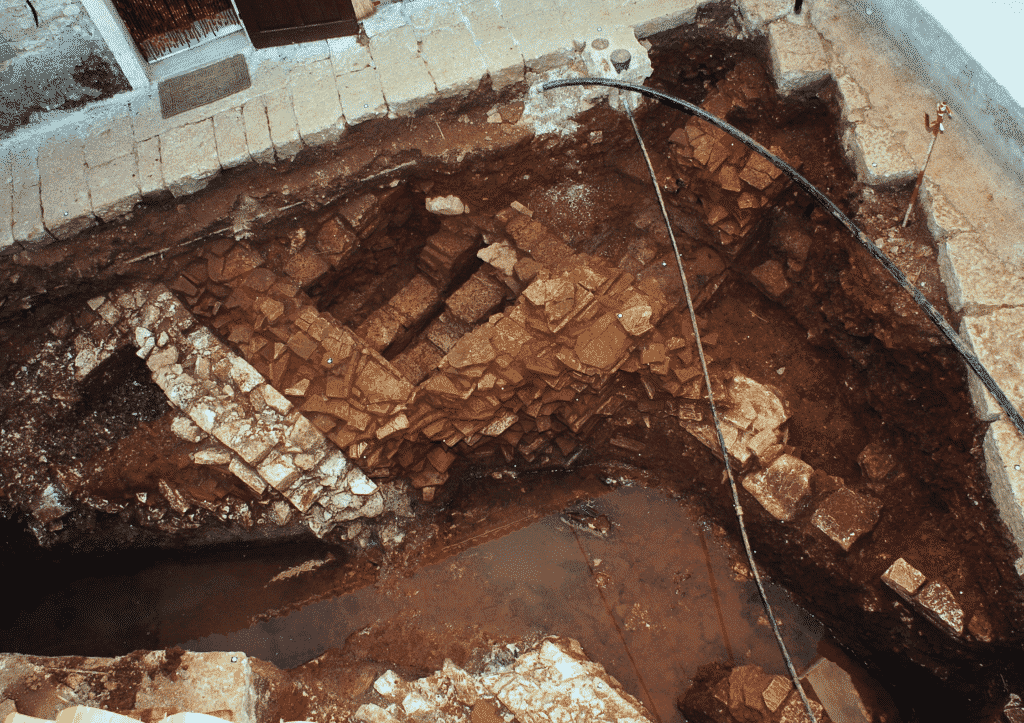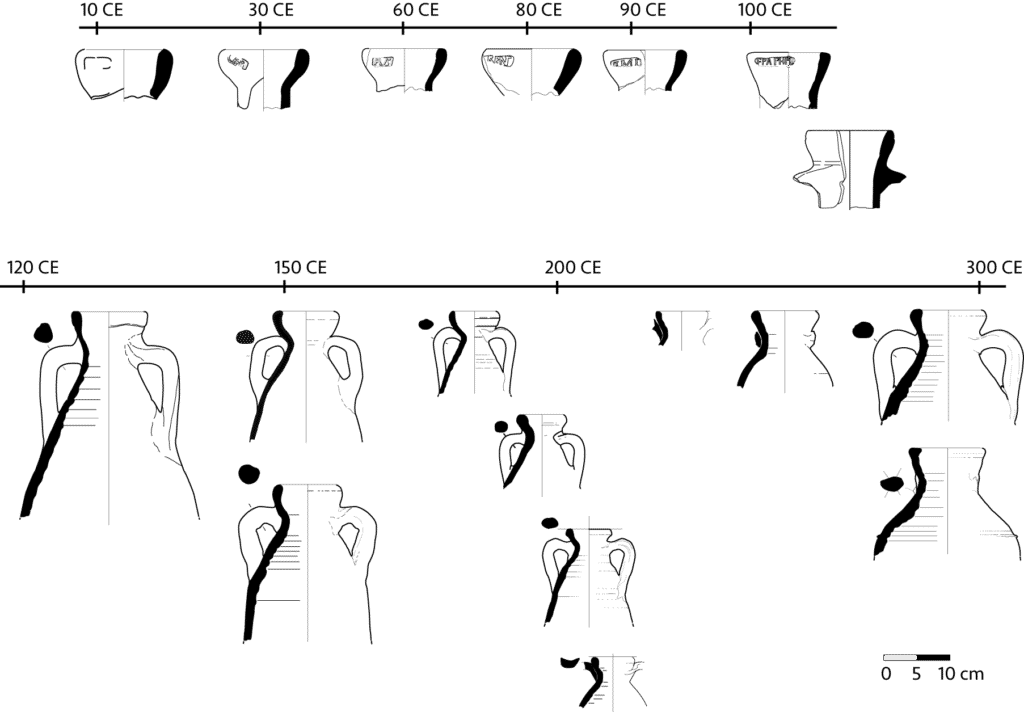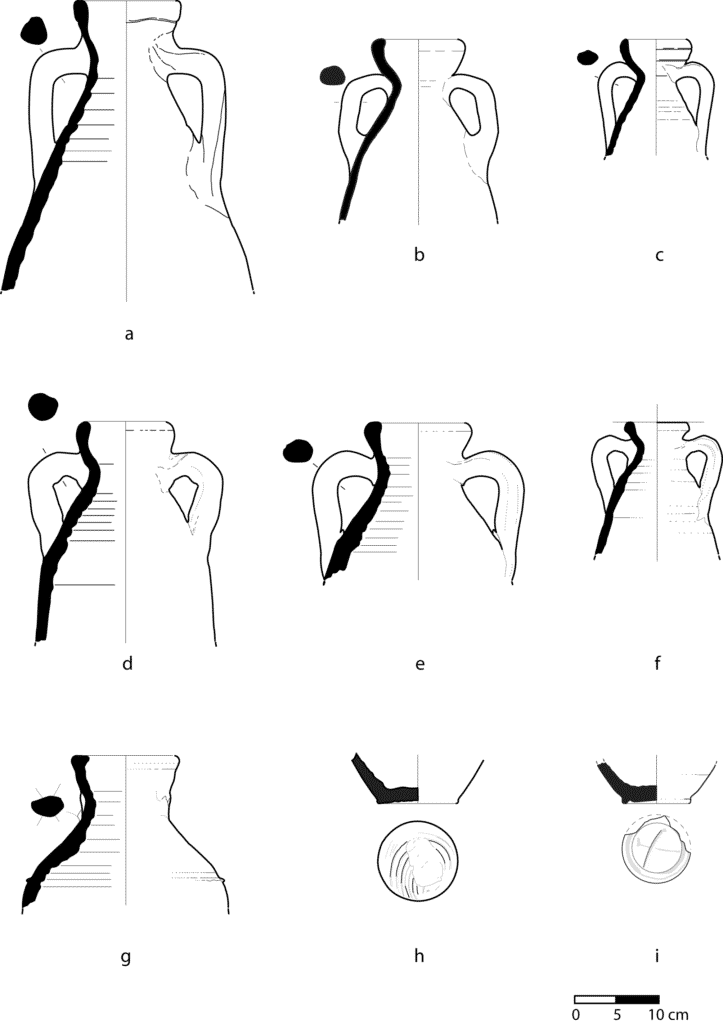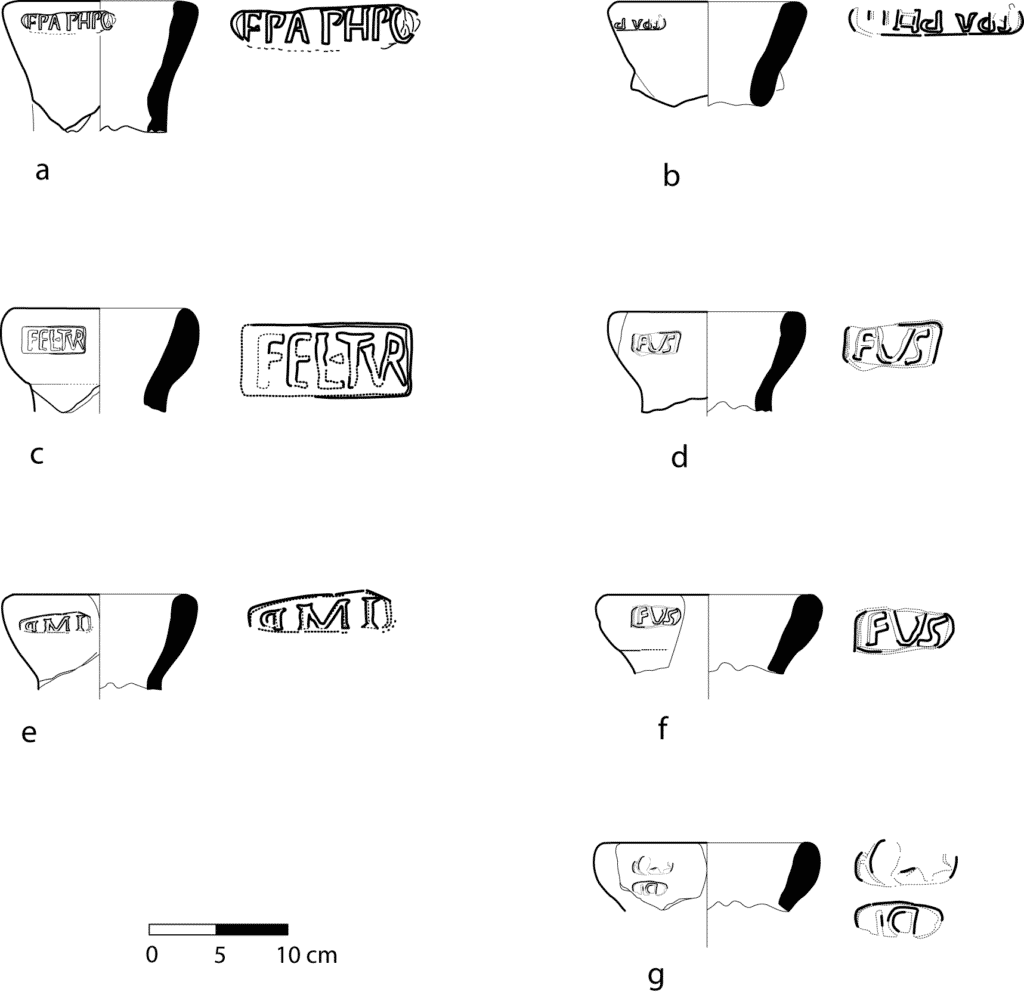The Pax Romana, instituted during the period of the emperor Augustus, was the primarily condition for both general societal progress and economic production. The individuals who were mainly involved in economic production and commerce, most often belonged to the senatorial and equestrian classes and also maintained control over the production of amphorae1. The advantageous geographical position of the Istrian peninsula as part of the Adriatic closest to the southeast-Alpine region below the Danube proved favourable to the development of a prosperous economy in Istria. This economy was mostly based on the production and export of Istrian olive oil (highly valued at the time). The pottery workshop in Fažana, situated approximately 7 km north-west of the Colonia Iulia Pola in today’s settlement of Fažana (fig. 1), during the 1st century was in the ownership of the senatorial Laecanius family, only to pass into imperial ownership during the reign of Vespasian2. According to the stamp on an amphora from Fažana in a later form, titled Marcus Aurelius Iustus, and on a votive altar from the Dobrika coast on the nearby Veliki Brijun island (commissioned by a person of the same name), it is conjectured that, towards the end of the 2nd or perhaps the beginning of the 3rd century, the pottery workshop was under the governance of the aforementioned Marcus Aurelius Iustus, and that it is possible that part of the Veliki Brijun3 island was under his governance as well. The colonate was quite widespread throughout the Empire in this period, so that it is possible that Marcus Aurelius was the holder of imperial properties in both Fažana and the Brioni islands.
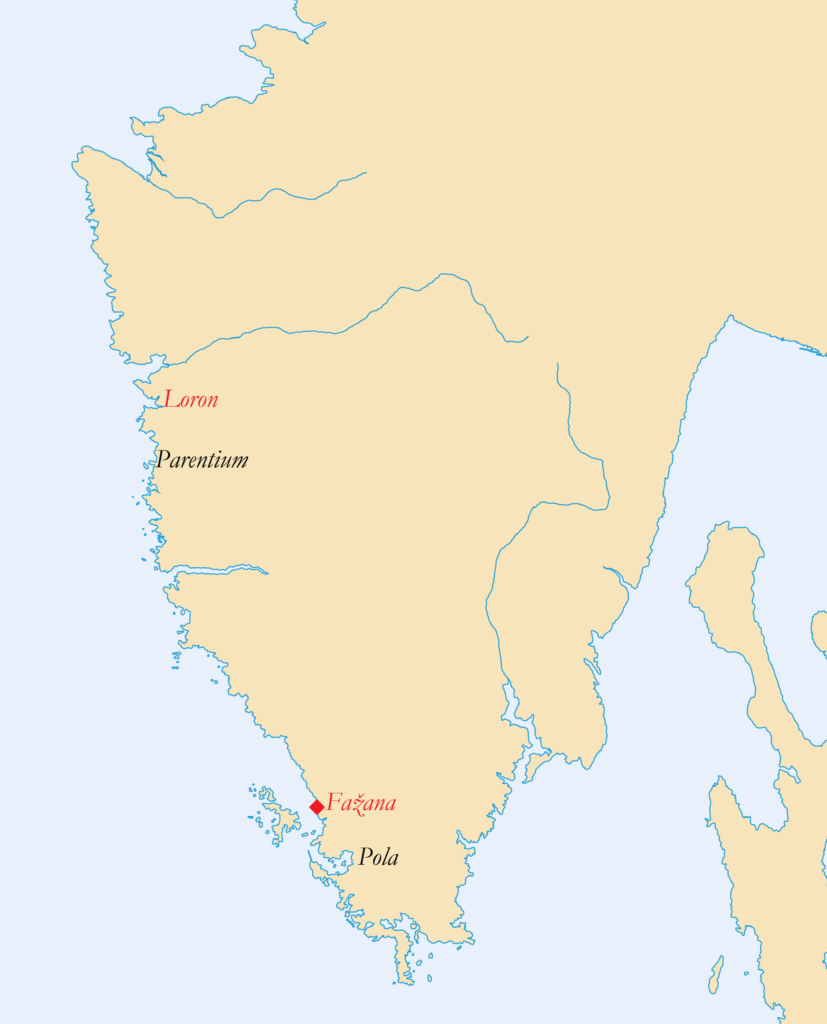
In the amphorae produced in the Caius Laecanius Bassus workshop, as was the case in the pottery workshop in Loron, which was situated north of the neighbouring Parentium colony, Istrian oil was exported to the wider region of the Pannonian provinces and the Noricum, to the lands of today’s Hungary, Austria, Slovenia, as well as to the North-Italic regions (Regiones Decima, Regio Undecima): through Padua to Turin and Vercelli, as well as other parts of the Empire, including Rome itself4. Although amphorae from Fažana have only been found sporadically in Rome and other parts of the Mediterranean, the primary commercial centre was located relatively close geographically. The proximity of the commercial centre for amphora and olive oil is entirely logical, taking into account the fact that the price of an agricultural product increased proportionately to every kilometre of transport, and this price increase was rather significant if the transport was by land5.
Architecture of the Pottery Workshop
Pottery workshops were spread out throughout almost the entire space of today’s historical core of the Fažana settlement, and contemporary buildings are directly founded upon Roman architecture: it is for this reason that a complete investigative excavation of this site is not possible. The recent findings on the architectonic remains of pottery workshops are based on the partially researched architectonic constructions of the remains of two kilns (A, B), cisterns (C), three peripheral walls (fig. 2) and several walls which (due to a lack of research) do not offer us enough information to enable a reconstruction of their form, size or the use of particular spaces in the workshop6. Several longer walls, which probably represent the peripheral walls of the workshop, have been recognised, and yet a lack of research does not allow us to ascertain the dimensions of the workshop complex. The architectonic complex is rectangular in form, the diagonals of which are directed toward the main parts of the world. According to the information available, the approximate area of the workshop is estimated to be about 5 000 m2 (fig. 3).
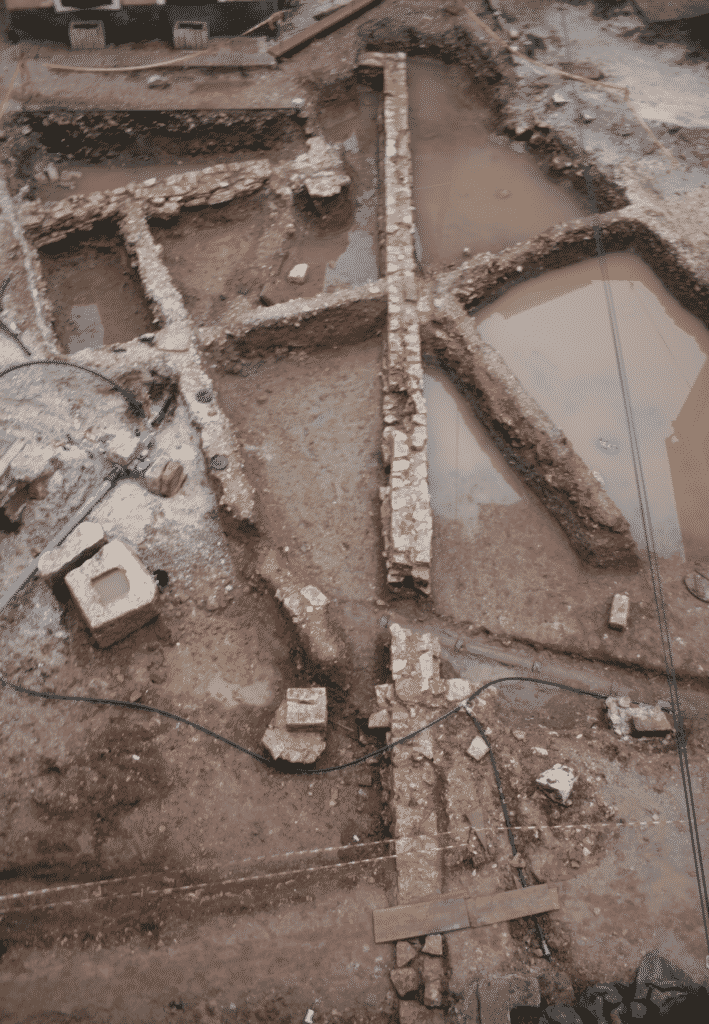
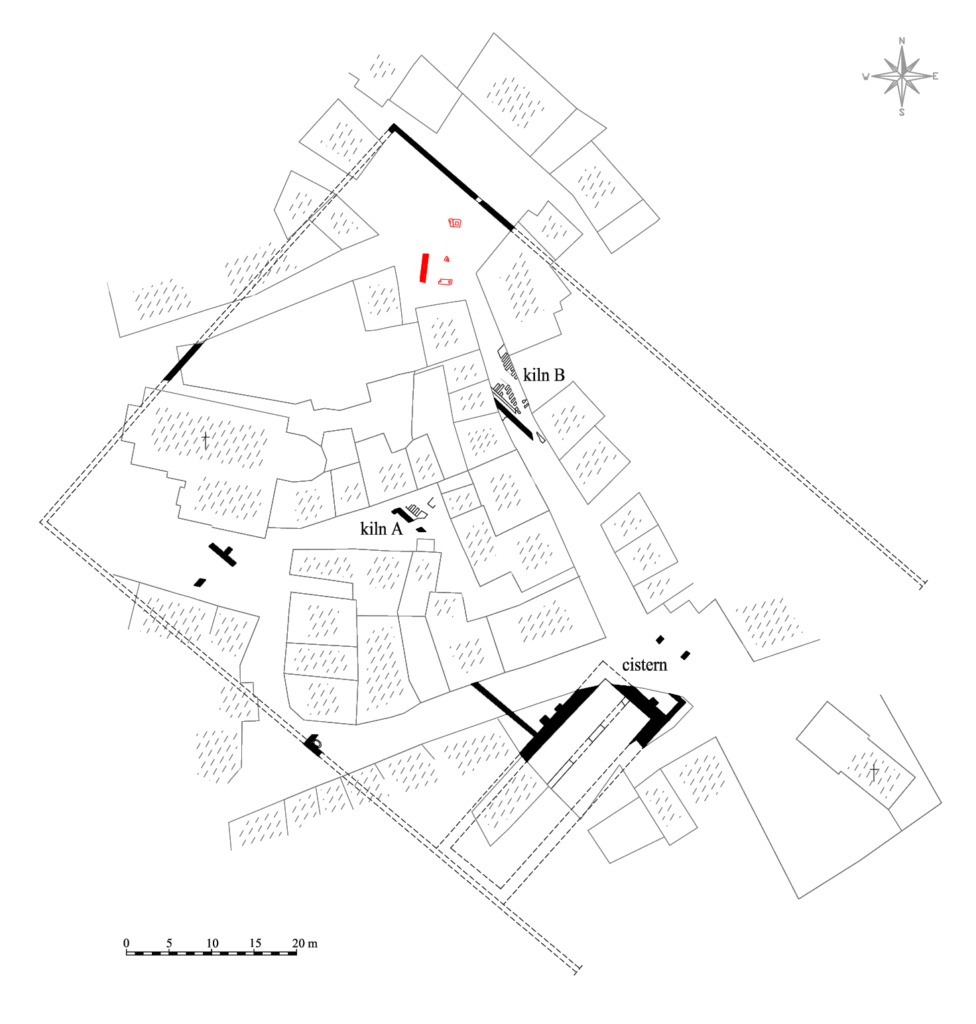
The Cistern
The cistern on its shorter side leaned on the southwest peripheral wall of the workshop. Due to the building which is there today (on the southwest part of the original workshop), it has only been researched in part (fig. 4), yet its dimensions have been reconstructed on the basis of a cadastral map from 1874 onto which it had been drawn. The outward dimensions of the cistern are approximately 10,2 x 30 m, and the height of the remaining walls is 1,84 metres. The entire volume of the cistern is estimated to be about 370 m3. The walls of the cistern were masoned with regularly hewn stones of almost equal proportions, using a calcerous mortar. These were fortified by butresses which widen in a trapozoidal manner toward the base, while the interior was divided by columns into two naves.
There is an interior peripheral wall from the modern era with arches which lean upon columns constructed upon the mid-longitudinal axis of the cistern, the purpose of which was to support the weight of the roof structure which most likely consisted of two barrel vaults. In this reconstruction from the modern era, which cannot be exactly dated, the original system of this structure from the Roman era was re-applied. Although archaeological research has not ascertained that an opus signinum was located on the interior side of the wall, nor has it been possible to locate the ancient bottom of the cistern by probe, the size of this object, as well as the methods by which its exterior walls were constructed, are evidence that this cistern belongs to the Roman era. Further evidence of this is its orientation, identical with the raster of other Roman architectonic remains7. Besides these technical characteristics, it has been confirmed that an integrally connected wall enclosing a rectangular space continues from the north-east wall of the cistern, within which an intact Roman cultural layer was found. Much is the case with the north-west side of the cistern, where a wall of this Roman construction in an intact Roman layer leans upon the most southerly excavated buttress. This Roman layer which consisted of earth and the debris of amphorae, as mentioned earlier, confirms that this cistern is from the Roman era.
Pottery Kilns
In2007 and 2008, two kilns have been excavated (in part) in the centre of the Fažana settlement (fig. 3 a, b) with a firebox and central corridor which longitudinally extend through the firing chamber8. The collected data provided insight into the techniques used by ancient workmen in order to insure the stability of the structure of the kiln in high temperatures during firing. Although these kilns belong to the identical type II b9 (according to Cuomo di Caprio’s typology), their means of construction still displays different approaches to structure. The walls of the south-west kiln (A), (the firing chamber in fact), were made using the common techniques for drywall from properly layered tegulae 65 cm in width (fig. 5). This method of construction based on the use of properly layered tegulae, is analogous to what we find in the larger kilns in Loron, yet also in other localities outside Istria10. Inside the firing chamber, the partitions or ribs of unfired brick have been partially preserved upon which the kiln grate leaned, in the form of perforated pottery plates which divided the firing chamber and the calcination chamber, yet kiln grate were not found during excavation. The available data provides insight into the internal width of the kiln at 4,1 m, whereas its length remains unknown.
There is a partially researched kiln (B), ten metres north-west in a neighbouring street, which has also been identified as of the II b type (fig. 6). The excavated part of the kiln is defined by the width of the contemporary street, due to the fact that modern buildings are above the north-east and south-west parts of the kiln. Many of its architectonic elements have been destroyed by the implementation of underground plumbing in 1909 and the construction of sewage infrastructure toward the end of the 1950’s (fig. 7). The entire internal width of the kiln was 4 m, whereas the external dimensions of the kiln were 11,16 x 6,7 m. The walls of the firing chamber were made of unfired bricks, as were the partitions in the interior of the chamber. The walls of the chamber were positioned above a multi-layered vertical structure from top to bottom in the following way: a 2,5 cm thick layer of tegulae, a 2 cm thick layer of amphorae fragments, a 11 cm thick layer of fatty green clay, after which the pattern is repeated with 2 cm thick amphorae fragments and 2,5 cm thick tegulae. These layers beneath the walls of the firing chamber, besides having a hydro-isolation function, also made the structure dynamic to changes conditioned by high temperatures. It is our opinion that the intention of the ancient builder was to diminish the coefficient of the dynamic rigidity of the structure by making, during the frequent changes in temperature while heating and cooling the kiln11, insignificant horizontal dislocations in the structure without which the structure would crack or warp. Although bricks are a building material greatly resistant to changes in temperature, ancient builders of kilns were faced, according to Cuomo di Caprio, with repairs for damages to ancient kilns caused by thermal processes12. Although built at the same time, the transverse ribs in the firing chamber are not organically linked to the longitudinal wall of the chamber, the purpose of which was to insure the dynamics of the firing chamber wall. It is exactly this kind of floor, which consisted of pottery plates (fragments of tegulae and amphorae in fact), as well as the firing chamber wall not being organically linked to the rest of the kiln, which allowed the horizontal dislocation of the chamber wall and prevented any instance of cracks or other irregularities in the structure.
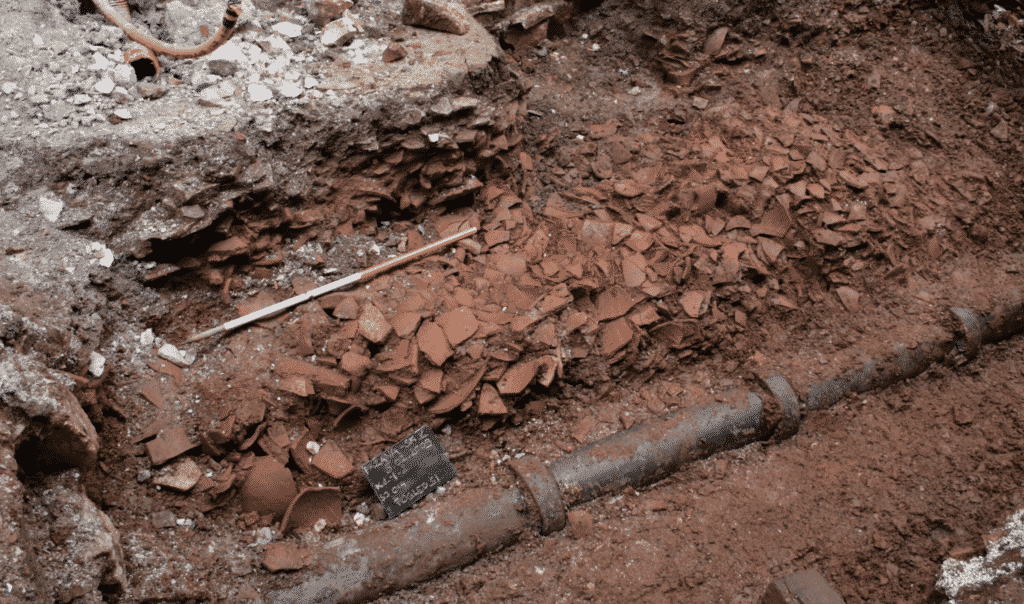
A different method of diminishing the dynamic rigidity of the structure was noted on the kiln (A). The walls of the chamber were not made of unfired bricks, but of regularly 65 cm width layered ceramic plates (tegulae) without solid binding material. This prevented any instance of cracks in the building as the structure of the wall itself ensures horizontal dislocations in the construction in cases of thermal changes. It was not necessary to construct a floor of multi-layered ceramic plates (fragments of tegulae and amphorae) for this kiln. The dynamic rigidity of the building was diminished due to the transverse ribs not being organically linked to the walls of the chamber. By using such technical means, the builder of this kiln greatly avoided instances of deformation in the shape of the kiln.
Both of the kilns described here, oriented in the direction north-west – south-east have been identified as type II b, characterised by a vaulted firebox in the central part of the kiln and a corridor functioning as a firebox which extends longitudinally through the firing chamber. This type of firing kiln has been found on the Istrian peninsula in Červar13 and Loron near Poreč14. In the chambers of these kilns, amphorae of smaller dimensions have been found (when compared to the classic Dressel 6B form from the 1st century), and which (according to Bezeczky) are dated as belonging to the second half of the 2nd and the beginning of the 3rd century15. Chronological and typological forms have also been found which, in a relatively chronological order, are most likely follow the so-called Fažana form 1 and form 2 from the 2/3rd century, and for now can be dated to the 3rd century, which also determined the last time the kilns excavated in Fažana were in use (fig. 8). The two partially researched kilns are at a distance of 10 m from each other and it can be justifiably conjectured that there was another kiln between them, yet this hypothesis, due to the existing buildings there, is not possible to either confirm or refute.
Products
The pottery products, which were deformed during the process of manufacture, were deposited within the workshop, yet the rather thick and compact layers consisting of fragments of unsuccessful pottery products were found throughout a wide area were research was conducted. The forms of amphorae which were excavated from the kilns provide a certain amount of insight into the inventory and quantity of certain types of products. Difficult circumstance in attempt to interpret a precise chronology of products is the fact that, throughout the entire pottery workshop, the stratigraphy of archaeological layers has been compounded due to earlier excavations of the streets of Fažana.
Amphorae
Most of the products made in the Fažana pottery workshop were amphorae for olive oil, known under the conventional title of Dressel 6B. In the variety of shapes of the Fažana amphorae (fig. 9)16 as of those of the same type from Loron17, the development of the Dressel 6B form through the entire period of the Principate can be observed18. On the basis of the stamp on Fažana amphorae found in other locations, Bezeczky developed a system of chronology of the Fažana amphorae, in which the chronologically determined forms of amphorae from the 1st century are in relatively short time intervals of one or two decades19. Furthermore, prosopographic data from the Loron amphorae also provides insight into the rather precise chronology of the forms of Istrian amphorae from the period of the 1st and the beginning of the 2nd century to the period of Hadrian20. Stamps, placed within a chronological series, were collected during three campaigns of protective research in Fažana between 2007 and 2009, as is the case with the results of research in other locations21, lead toward the conclusion that the greatest intensity of the production and export of products from Fažana was during the first half and middle of the 1st century. The greatest leap in the production and export of Fažana amphorae occurred in the second quarter of the 1st century, in the time of its first known owner, Caius Laecanius Bassus,who had then, as praetor urbanus in 32 CE and consul suffectus in 40 CE, held high state offices, which he had certainly been able to utilise for the development of his business practices. The rationalism of business and the desire of the senatorial aristocracy to gain capital can be seen in the remains of the Roman rural architecture on the neighbouring Brioni islands, which were also likely in the ownership of Caius Laecanius Bassus22.
The younger forms of Fažana amphorae have morphological similarities with the Northern Adriatic type of amphora with a funnel shaped rim. This form, often decorated with a single wave-like line beneath the rim, has been chronologically certified in the Fažana site with the stamp of Hadrian23 (fig. 10 a). The analogous forms in Loron, where an almost identical evolution of the Dressel 6B form has been confirmed as in Fažana, are dated from Domitian’s reign to that of Hadrian24 and even in the later period (see above Y. Marion and F. Tassaux’s contribution). Amphorae of smaller dimensions than those from the 1st century have been found in the kilns (fig. 10 b, c, d, f). Bezeczky does not consider these forms as belonging to the Dressel 6B type, but has typologically named them Fažana 1 and Fažana 2, and has dated them to the second half of the 2nd and the beginning of the 3rd century25. On the other hand, there is conjecture that the Fažana 1 type is a continuation of the evolution of the Dressel 6B form from the beginning of the 2nd century, with which it shows morphological similarities due to its funnel shaped rim and ovoid body26. The Fažana 2 type represents a further reduction in the volume of the Fažana amphorae when compared to the Fažana 1 type. The interior side of the rim is concave; its handles are more elongated, while the body of the amphorae is also of an ovoid shape. The amphorae of smaller dimensions are of a hard fabric, with visible traces of the process of production on the potter’s wheel on the outer wall of its belly (fig. 10 c, f). Besides these amphorae, other forms have been noted in Fažana which are somewhat different from those described heretofore and have not yet been included in any system of contemporary typology. This instance refers to a form of amphorae which have a slightly concave rim on the interior side and a flat rim on the upper side under which small handles protrude that are circular in shape (fig. 10 e, g). Individual specimens have an emphasised transition from the neck into the belly of the amphorae. The formation of the upper part of the amphora evinces developmental similarities to those in Loron, which belongs to a subtype of latter forms of amphorae, known as variant 2. An amphora possessing the same morphological characteristics has been excavated and dated to a context of the second half of the 3rd or beginning of the 4th century in Aquileia27.
A large number of excavated specimens have flat bases, indicative of the possibility of the production of amphorae with flat bases (fig. 10 h, i). Taking into account that in the pottery workshop in Loron, the production of amphorae with flat bases has been noted as well, one can make the justified conjecture that amphorae with flat bases had also been produced in Fažana. As is not the case in Fažana, the upper parts of amphorae with doubly profiled rims (unique thus far) have been found in several instances, which display similarities to Oberaden 74, Gauloise 2 or Dressel 28 forms. Questions regarding the time of the production of the forms in Loron, their typological development and the products for which they were used, remain unanswered. It is possible that such amphorae were produced in Loron at the beginning of the 1st as they have been found in the same layers as the Dressel 6B amphorae marked with the stamp SISENNAE (the first owner of the workshop), and it has been suggested that they were used for wine28.
A summary typological analysis of Fažana amphorae allows us to make a general conclusion on the production of amphorae in Fažana during the first three centuries of the Common Era, also concerning the various intensity of their production (which was greatest during the first half and middle of the 1st century). Bezeczky, on the basis of research on the storage spaces in villas on the Brioni islands, makes the estimate that the annual production of amphorae in Fažana during the 1st century was approximately between 10 and 12 thousand per year29. Although there was a decrease in the production of amphorae in Fažana in the 2nd century, the morphological variety of the shapes of amphorae indicates the great productive continuity of these workshops three centuries after Christ.
Besides amphorae and amphorae lids, which composed the primary inventory of products intended for the distribution of Istrian oil through the wider market of the Empire, other objects intended for building and other utilitarian purposes were also produced in these pottery workshops. In these kilns, besides amphorae and their lids, spicae were also found; examples from the Brioni islands and Pula, with the stamp Caius Laecanius Bassus30, are evidence of the production of tegulae. In Fažana, the upper part of a ceramic mould for the production of “Firmalampen” oil lamps was found in 1909, known as the Loeschke IX-X31 type. Tegulae with the Laecanius stamp were found in a rather small area in the vicinity of these pottery workshops, which indicates that these types of products, when compared to the production of amphorae, were produced in smaller quantities, enough to satisfy the needs of estates of the latifundia type, with a larger number of structures located in different, often physically unconnected, spaces32. It is obvious that the owners of these pottery workshops, participating in the commercial exploitation of agriculture, besides products intended for the wider market, also produced goods intended for the needs of their own properties.
Observations on some of the stamps in the Fažana Pottery Workshops
One of the specific peculiarities of the Fažana pottery workshops can be seen in the stamps of the master-workman (officinator) or manager (vilicus), which often appear beside the stamps of the proprietor (dominus)33. Bezeczky claims that these are managers who were also responsible for the production of olive oil. According to Bezeczky in the period between the reigns of Tiberius and Claudius (a period of time covering some 30-35 years), 20 to 22 managers were employed on the property of Laecanius. Between the reign of Claudius and the Flavian dynasty (also covering a period of 30-35 years), some 18 to 20 vilici are known. Bezeczky concluded that it is somewhat possible that the vilici spent one to two years on the property and consequently, proposed that there was more than one director on the property at one time who were allocated different ranks34. Due to the absence of solid arguments, it should be noted that it is not entirely clear whether the people mentioned on the Fažana amphorae were manager or workmen.
Stamps on the Fažana amphorae appear until the time of the reign of Hadrian, while they do not appear on forms from later periods. The stamps of master-workmen or directors are names of those whose origins were in the servile classes, which can be seen in the pattern of nomen, taking into account that only one name is indicated. There are forty names which have been noted on amphora beside the stamp of Caius Laecanius Bassus35, ten names, respectively, of workers connected to imperial property36. Three master-workmen or directors who marked amphorae with the stamps CLYMEN, PAGANI, DAT/DATI, evince changes in the ownership of the workshop, actually meaning its transition into imperial ownership, as their stamp appear beside the Laecanius and imperial stamps37. What follows are some considerations in three newer forms of the stamp of master-workmen or directors (EPAPHRO, FEL·TVR and FVS) which were found during the protective excavations conducted between 2007 and 2009.
On six fragments of amphorae with short funnel-shaped rims, curated in the Archaeological museum of Istria, beneath the margin of its opening are EPAPHRO38 stamps (fig. 11 a, b). The name of this workshop master-workman or director is of oriental, Greek, origin, and we read it as Epaphroditus39. This name was common throughout the entire period of the Roman Empire, and can be found on Roman and Greek inscriptions either in its integral or shortened form as Epaphras40. It is known in the form of Aphroditus41 in the region of Dardania, and it is also known in Christian onomastics42. This is a name which is theophoric in character, derived from the name of the Greek goddess Aphrodite, whose cult originated from the synthesis of elements of Greek and Semitic religions. In Latin onomastics this name corresponds to the name Venustus, as well as Venerius. In the conceptual framework of the Roman pantheon of the 1st century BCE, Venus became protector of land and sea, while the Greek tradition of Aphrodite as goddess of love, libido and hedonism continued to be maintained. By receiving the attributes of Euploia (the goddess of good sailing and maritime ventures) Venus was linked to economic production in the sense of progress, plenty, thus good fortune43. Roman cognomen, the names, in fact, of slaves whose names are not only abstract concepts without content and further meaning, also express certain physical, intellectual and geographical characteristics, furthermore, moral, political, social and religious points of view. People, whose freedoms were limited, received names from their masters, who were inspired to name them for various reasons. According to certain authors, Epaphroditus is metonymic for “handsome”, “charming”44. Meanwhile, it is possible that the Epaphroditus mentioned on the Fažana amphorae received his name from his master or imperial director, and that its meaning was apotropaic in the sense of protection of the workshop, ensuring its economic development and progress. Theophoric names certainly possess a deeper meaning than simply an expression of certain physical characteristics. Fragments of amphorae on which stamps with the name Epaphroditus have been found, display morphological similarities to North-Adriatic amphorae with funnel-shaped rims, their production in Fažana is dated with the stamp of Hadrian45. Taking this into account, stamp of this type should be dated to the end of the 1st or beginning of 2nd century.
In the ager of Pula, the name Epaphroditus has been noted on several epigraphic monuments. In the vicinity of Pula, beside the Vodnjan road, two lead plates on which a total of 26 different names, among which the name of Minervius Epaphroditus46 is inscribed, were found in a grave at the beginning of the 20th century. Interestingly, on these tiles agricultural professions are written along with ten names, which also makes this a unique resource for research into the social status of agricultural labourers47. The writing system used on these plates contains elements of Graeco-Latin calligraphy: Brancale dated these plates somewhere within the period of the mid-2nd to the mid-3rd48, but also claiming that the second plate is of an earlier date. It is somewhat difficult to say something on the true nature of these plates and it is possible that those mentioned on it belonged to some kind of guild, perhaps for the worship of some religious cult49. It is also difficult to link the person, whose name is mentioned on the amphora from the Fažana workshop, to the name mentioned on the plate, although this is a conjecture which should not be entirely disregarded, especially seeing that the older plate originated in the mid-2nd century.
The name Epaphroditus has also been noted on three inscriptions from Pula, of which only one has been preserved in its entirety:
- D(is) M(anibus) / Aurelio Cresentia coniugi C(aio) Au[r(elio)] Epaprodito / con quo vixit annis XI, de suo posuit b(ene) m(erenti) 50
- [-aur]unceius [Epaphr]oditus [—] 51
- [—E] paphr[odit—] 52
A stamp of the FEL·TVR53 form (fig. 11 c) was found on the rim of a Dressel 6B amphora in Fažana in 200754. It is possible that this stamp represents a variant of the FELIX·TVR stamp type which also appears on the Dressel 6B which was found in Magdalensberg, Salla and Patavium55. On the amphora rim from Patavium, beside the stamp FEL·TVR is the stamp of dominus, C·LAEK56. The stamp FEL·TVR can be read as Felix Tvrranianus or Turianus. The cognomens Tvrranianus and Turianus have also been noted in the provinces of Dalmatia and Italy57. Although can be read as Felix Turpilianus, gens Turpilia which was noted in Pola and Aquileia58. The pattern of nomen for this person consists of a two-part formula, a cognomen and an agnomen. The cognomen containing the suffix –anus/na regularly represents derivatives pertaining to gentilicius, indicating subjection to a certain gens59. It is possible that the aforementioned master-worker changed owners and was now in the ownership of Caius Laecanius Bassus and that he had also maintained his earlier name. The name Felix indicated the good fortune of whoever had received it. In fact, the cult of Fortuna, as was the case with the cult of Venus, experienced a full affirmation in the late Republic60. Land and sea were also under Fortuna’s protection, as she was the bringer of welfare and fortune. Taking this into account, we can also recognise a theophoric component in the name of this master-worker, which was apotropaic in character for its owner in the sense that it was to insure divine favour, prosperity and economic wealth. Several other stamps with the agnomen Felix have been found in the Fažana workshop; FELIX PET, FELIX SER61, FELIX SCR62. The stamps with an agnomen are generally dated to the initial period of the figlina, in the late Augustan, Tiberian or in early Claudian period. During that period, Caius Laecanius Bassus probably employed local, already specialized workers63. The rim with the stamp FEL·TVR shows morphological similarities with the rims which have stamps FELIX SER and have been dated in late Augustan period64.
The third stamp FVS which is expanded as Fuscus65, belongs to the group of cognomina derived from the physical characteristics of the body. In this case, the name refers to the colour of the skin (lat. fuscus = dark, brown), by which it is possible to explain the greater frequency of this name among slaves and freemen66. FVS stamps can be found on two rims on the openings of amphorae of different profiles67. The first fragment (fig. 11 d) has the same profile as the known fragments of the rim with the mark of imperial ownership IMP (fig. 11 e), whereas the second fragment (fig. 11 f) displays a typological similarity to the fragment marked by the stamp (fig. 11 g), which is dated to the Claudian /early Flavian period68. It is possible that the aforementioned Fuscus witnessed a change of owner, yet until the imperial stamp, which is directly connected to the name of this master-worker, is found, this can not be entirely confirmed. Fragments which possess a thicker rim protruding outward (fig. 11 d) represent a typological form of amphorae, the production of which began before 78 CE, and continued under imperial ownership, possibbly until the late periods of Trajan and Hadrian, when began the production of amphorae with short funnel-shaped rims, which display typological similarities to Northern Adriatic amphorae with funnel-shaped rims.
Changes in Pottery Workshops in Late Antiquity
The economic and political circumstances characterisitc of the period of late antiquity also profoundly influenced Roman rural architecture, especially those structures whose intention included content for economic ventures69. The Roman rural architecture, which in the early period of the Empire was intended for the production of ceramics, experienced a change in late antiquity in both the labour involved in production, as well as in approaches to architecture. At the location of what was once the pottery workshop (which had reached its apex in the 1st century) is a facility for the processing of oil or grapes, the orientation of which deviates from the first structural phase.
On the Piazza Grande of today’s Fažana, three elements of a press were uncovered. The elements show similarities to the C3 type, according to Brun’s typology70 The stone block interpolated into the north-east corner of the Piazza Grande is also connected to the pressing mechanism for agricultural fruits71. Their presence raises two questions: what was the destination of this press, for the production of oil or wine? Was it the sign of a new vocation of this sector or had it been brought from some location of Roman rural architecture in the vicinity? Excavations have not been able to provide evidence which undoubtedly confirms the type of production in Fažana, so that it is not possible to unequivocally determine the kind of fruit which was processed in this press. On the basis of stratigraphic indicators, the construction of this press should be placed after the cessation of pottery production (in the 4th or 5th century), yet the precise time of its origin cannot determined with greater precision. The time-span when this press was in use offers us a rather humble repertoire of rough kitchen pottery, found in the same layer as the remains of the press itself. In this case, these are flat-based pots of hard fabric, with a vertical brush-like ornamentation covering its entire exterior (such were common in the Northern Adriatic and Eastern Alpine regions from the 4th to the 7th century72), as well as a fragment of north African terre sigillate from the 5th century.
The archaeological and historical research did not recorded a population decrease in Istria during the period of late antiquity. But it is obvious that a habitation in the majority of rural locations was continued until the early Middle Age73. Agricultural production had been adapted to new economic and societal circumstances74. In the case of the Roman rustic villas (villa rustica) of the Northern Adriatic in late antiquity, there was a definite decrease in the capacities of production75. Agricultural production in Istria was eventually based on personal use only, and any resulting surplus was sold commercially within smaller, regional markets.
Analogous to the processes of the transformation of Roman rural architecture throughout the Empire76, it is possible that the villa in Fažana, at the dawn of the Middle Ages, by the process of nucleation, became the focal point for more intense settlement and construction, resulting in the settlement prior to the Fažana of today. And yet, protective archaeological research has not been able to document any remain which can be linked to Medieval Fažana (in sources known under the vicus Fasano from 1150, or Wasana from the beginning of the 13th century77). With the exception of certain ceramic fragments which are dated to the 18th century78, as well as certain walls which the limited area of investigation does not allow us to place in a meaningful context, other archaeological data on Modern Age Fažana has not been found. The reasons for this must be sought in the fact that today’s structures in the old core of Fažana conceal facts on the development of this settlement underneath their foundations.
After a close observation of the geodetic circumstances of the pottery workshop and its interrelation to the modern cadaster, an interesting fact arises that the oldest surviving structure in the old core of Fažana (the church of St. Mary Carmelite from the second half of the 14th century), is also the only structure in Fažana which has the same orientation as the ancient pottery workshop (fig. 3). In accordance to the recognised examples of medieval sacred structures on sites of Roman rural architectonic complexes, it is possible that this gothic structure (of which there are opinions regarding its earlier, Romanesque phase) is founded on the remains of Roman architecture79. A slight deviation in the orientation of architecture in late antiquity in relation to the pottery workshop of the early Empire, noted on its northern part, does not necessarily mean that there was a simultaneous change in architectonic orientation in the entire region of the former pottery workshop. Certain spaces of the former pottery workshop, albeit for different purposes, were probably also used in early – late antiquity and the early middle Ages. The identical orientation of the church of St. Mary Carmelite and the ancient pottery workshop contributes to the expressed opinion on the continuity of the settlement of this location from the period of the early empire, although we are still lacking unequivocal arguments that could contribute to this hypothesis.
Conclusion
Due to the current settlement in Fažana, it is not possible to confirm the architectonic ground plan of the pottery workshop in great detail. Fieldwork thus far has only managed to cover a smaller range, so that a more precise interpretation of the organisational process of the production of ceramic products (other than the firing process), remains unknown. The production of amphorae in Fažana lasted throughout almost the entire period of the Principate, although the most intense period of the production and export of Fažana amphorae was during the first half and middle of the 1st century. The development of the Dressel 6B amphora form in Fažana indicates highly similar, and in some cases identical, morphological characteristics to the amphorae produced in the Loron pottery workshop, in the region of the ager of the neighbouring colony of Parentium. Taking this into account, the time period in which both pottery workshops were active is almost identical. The Fažana pottery workshop was primarily intended for the production of amphorae and other, still unidentified forms, in its later phase; toa lesser extent it also produced building materials and other implements for its owner’s use or perhaps for commercial sale within the smaller regional market. Meanwhile, when compared to the Loron pottery workshop, the production of ceramics of the terra sigillata has still not been confirmed in Fažana. One of the specifics of the Fažana pottery workshop are the stamps of workshop master-workmen to which were recently also added the forms of stamp EPAPHRO, FEL·TVR and FVS. These stamps are related to the names Epaphroditus and Felix Tvrranianus or Turianus and Fuscus. The first two names belonging to workshop master-workmen are theophoric in character. The name Epaphroditus is Greek in origin and is derived from the name of the Greek goddess Aphrodite, while the name Felix is linked to goddess Fortuna. It is possible that these names had an apotropaic meaning for the proprietor or imperial director of the workshop.
In late antiquity the pottery workshop went through changes,
both in its mode of production, as well as in its architectonic concept. In
place of the former pottery workshop is a plant for the processing of olives
and grapes. It is possible that at the dawn of the middle Ages the former
pottery workshop became a place of increased settlement, by which it was
transformed into the settlement which preceded the contemporary settlement of
Fažana.
References •••
- Baldacci, P. (1969): “Alcuni aspetti dei commerci nei territori cisalpini”, in: Atti del Centro studi e documentazione dell’Italia Romana, 1, 7-50.
- Baldacci, P. (1972): ”Importazioni cisalpine e produzione apula”, in: Recherches sur les amphores romaines, Actes du Colloque de Rome (4 mars 1971), Coll. EfR 10, Rom, 17-28.
- Begović, V. and Schrunk, I. (2001): “Preobrazbe rimskih vila na istočnom Jadranu u kasnoj antici i ranom srednjem vijeku”, Prilozi instituta za arheologiju u Zagrebu, 18, 157-171.
- Benquet, L. (2015): “Les marques sur amphores et les vins de l’Étrurie romaine en Bourgogne au IIe et Ier s. av. n.è.”, in : La marque et le vin. Vins de marques et marques de vin, Actes des sixièmes rencontres “Aujourd’hui, l’histoire des Bourgognes”, Beaune, 9 mai 2015, Cahiers d’histoire de la vigne et du vin 15, Beaune, 11-21.
- Bezecky, T. (1987):Roman Amphorae from the Amber Route in Western Pannonia, BAR Int. Ser. 386, Oxford.
- Bezecky, T. (1998):The Laecanius Amphora Stamps and the Villas of Brijuni,Verlag der Österreichischen Akademie der Wissenschafte, Wien.
- Bezecky, T. (2001):“The chronology of the end of the Laecanius workshop”, in:Carinthia romana und die römische Welt, Festschrift für Gernot Piccotini zum 60. Geburtstag, Klagenfurt, 421–425.
- Bonifay, M. and Tréglia, J.-C., ed. (2007): Late Roman Coarse Wares, Cooking Wares and Amphorae in the Mediterranean, BAR Int. Ser. 1662 (I), Oxford.
- Brancale, G. (1981): “Due lamelle letterate dal Polesano”, Archeografo Triestino, 4, 41 (90), 7-32.
- Brun, J. P. (1986): L’oléiculture antique en Provence, Les huileries du départment du Var, RAN Suppl. 15, Montpellier.
- Buchi, E. (1975): “Commerci delle anfore ‘istriane’”, Aquileia Nostra,45-46, 431–445.
- Bulić, D. (2009): “Prilog poznavanju žigova na amforama fažanske radionice”, Histria Antiqua, 18/1, 257-270.
- Bulić, D. and Koncani Uhač, I. (2011): “Figlina u Fažani i njezina preobrazba u kasnoj antici [The Pottery Workshop at Fažana and its Transformation in the Late Roman Period]”, Histria Archaeologica, 41/2011, 109-146.
- Carre, M.-B. (1985): “Les amphores de la Cisalpine et de l’Adriatique au début de l’Empire”, MEFRA, 97, 207-245.
- Cipriano, S. and Ferrarini, F. (2001): Le anfore romane di Opitergium, Treviso.
- Cipriano, S and Mazzochin, S. (1998): “I bolli di C. Laecanius Bassus, un aggiornamento alla luce di nuovi dati da Patavium”, Aquileia Nostra, 69, 361-378.
- Cuomo di Caprio, N. (1971-1972): “Proposta di classificazione delle fornaci per ceramica e laterizi nell’ area italiana, dalla preistoria a tutta l’ epoca romana”, Sibrivm,11, 371–464.
- D’Incà, C., Kovačić, V., Marchiori, A., Marion, Y., Rousse, C., Tassaux, F. and Zabeo, M. (2008): “Loron – Lorun, Parenzo – Poreč, Istria. Una villa maritima nell’agro parentino: la campagna di ricerca 2007”, Histria Antiqua, 16, 147-160.
- D’Incà, C., Kovačić, V., Marchiori, A., Marion, Y., Rousse, C., Tassaux, F. and Zabeo, M. (2010): “Loron – Lorun, Parenzo – Poreč, Istria. Una villa maritima nell’agro parentino: la campagna di ricerca 2009”, Histria Antiqua, 19, 313-327.
- De Franceschi, C. (1939–1940): “La toponomastica dell’antico agro polese desunta dai documenti”, in: Atti e memorie della Società Istriana di Archeologia e Storia Patria, 51–52, 119–198.
- Degrassi, A. (1956): “L’ esportazione di olio e olive istriane nell’ età romana”, Atti e Memorie della Società Istriana di Archeologia e Storia Patria, 4, 104–112.
- Duncan-Jones, R. P. (1982): The Economy of the Roman Empire, Quantitative Studies., Cambridge.
- Džin, K., Koncani Uhač, I. and Bulić, D. (2007): “Arheološka istraživanja stare gradske jezgre Fažane”, Obavijesti Hrvatskog arheološkog društva, 3, 61-73.
- Forlati Tamaro, B. (1947): Inscriptiones Italiae, Vol. X, Regio X, fasc. I – Pola et Nesactium, Rom.
- Gnirs, A. (1910): “Eine römische Tonwarenfabrik in Fasana bei Pola”, Jahrbuch für Altertumskunde,4, 79–88.
- Green, K. (1986): The Archaeology of the Roman Economy, London.
- Hulit Gloer, W. (1990): “Epaphroditus”, in: Mercer Dictionary of the Bible, ed. W. E. Mills, Georgia, 254.
- Jurkić, V. (1979): “Scavi in una parte della villa rustica romana a Cervera Porto presso Parenzo, Campagne 1976–1978”, Atti del Centro di Ricerche Storiche di Rovigno,9, 263–298.
- Jurkić, V. (1981): “Građevinski kontinuitet rimskih gospodarskih vila u zapadnoj Istri od antike do bizantskog doba”, Histria Historica, 2, 77–106.
- Jurković, M., Marić, I. and Terrier, J. (2009): “Crkva sv. Šimuna, srednjovjekovno naselje Guran, crkva sv. Cecilije”, Hrvatski arheološki godišnjak, 5/2008., Zagreb, 331-333.
- Kajanto, I. (1965): The Latin Cognomina, Helsinki.
- Kovačić, V., Marchiori, A., Marion, Y, Rosada, G., Rousse, C. and Tassaux, F. (2011): “Loron-Lorun, Parenzo-Poreč, Istria. Una villa maritima nell’agro parentino: la campagna di ricerca 2010”, Histria Antiqua, 20, 515-525.
- Laurence, R. (2005): “Land transport in Roman Italy: costs, practice and the economy”, in: Parkins & Smith, ed. 2005, 125-143.
- Lipovac Vrkljan, G., Radić Rossi, I. and Šiljeg, B., ed. (2011): Rimske keramičarske i staklarske radionice, Proizvodnja i trgovina na jadranskom prostoru, Zbornik I. međunarodnog arheološkog kolokvija, Crikvenica, 23. – 24. listopada 2008., Crikvenica.
- Lorenzo, B., ed. (2002): I greci in Adriatico, 1, supplemento del convegno internazionale, Urbino 21-24 ottobre 1999, Rom.
- Maggi, P. and Marion, Y. (2011): “Le produzioni di anfore e di terra sigillata a Loron e la loro diffusione”, in: Lipovac Vrkljan et al. 2011, 175-187.
- Mange, M. A. and Bezeczky, T. (2006): “Petrography and Provenance of Laecanius Amphorae from Istria, Northern Adriatic Region, Croatia”, Geoarchaeology: An International Journal, 21.5, 429-460.
- Marchiori, A., D’Incà, C., (2011): “Le fornaci di Loron (Istria, Croazia)”, in: Lipovac Vrkljan et al. 2011, 83-90.
- Marin, E. and Mazzoleni, D., ed. (2009): Il Cristianesimo in Istria fra Tarda Antichità e Alto Medioevo. Novità e riflessioni, Atti della giornata tematica dei Seminari di Archeologia Cristiana (Roma, 8 marzo 2007), Rom.
- Marion, Y. and Starac, A. (2001): Les amphores, in: Tassaux et al., ed. 2001, 97-125.
- Marušić, B. (1975): “Neki problemi kasnoantičke i bizantske Istre u svjetlu arheoloških izvora”, Jadranski zbornik, 9, 335-350.
- Matijašić, R. (1988a): Ageri antikih kolonija Pola i Parentivm i njihova naseljenost od I. do III. stoljeća, Zagreb.
- Matijašić, R. (1988b): “Kasiodorova pisma kao izvor za poznavanje kasnoantičke povijesti Istre”, Zgodovinski časopis, 42, 363-371.
- Matijašić, R. (1997): “L’Istria tra l’antichità classica e la tarda antichità”, Arheološki vestnik, 48, 203-218.
- Matijašić, R. (1998): Gospodarstvo antike Istre. Arheološki ostaci kao izvor za poznavanje društveno-gospodarskih odnosa u Istri u antici (I. st. pr. Kr.–III. st. po. Kr.), Pula.
- Matijašić, R. (2009): “Società e commercio nell’Istria e i rapporti con il Mediteraneo nella tarda antichità”, in: Marin & Mazzoleni, ed. 2009, 47-69.
- Mirdita, Z. (1998): “Teoforična imena u onomastici Dardanije”, Vjesnik arheološkog muzeja u Zagrebu, 30-31, 33-45.
- Musti, D. (2002): “Il contesto cultuale e storico della Fortuna di Fano”, in: Lorenzo, ed. 2002, 25-60.
- Paić, A. and Bulić, D. (2008): Katalog/Catalogo, in: Džin, K. (ed.), Fažana ispod pločnika/Sotto il lastricato di Fasana, Catalogo 74, Museo Archeologico dell’Istria, Pula, 17-40.
- Parkins, H. and Smith, C., ed. (2005): Trade, Traders and the Ancient City, London – New York.
- Percival, J. (1976): The Roman Villa. An Historical Introduction, London.
- Pesavento Mattioli, S., Mazzocchin, S. and Pavoni, M. G. (1999): I ritrovamenti di anfore presso l’anfiteatro romano di Padova, Bollettino del Museo Civico di Padova, 88, 7-44.
- Santoro, S. (2007): “Le ceramiche da cucina prodotte in Italia ed esportate nel Mediterraneo: un primo panorama archeometrico ed archeologico sulla base di una banca dati”, in: Bonifay & Tréglia, ed. 2007.
- Starac, A. (1997): “Napomene o amforama Dressel 6B”, in: Arheološka istraživanja u Istri. Znanstveni skup Poreč, 25.-26. IX. 1994. Izdanja Hrvatskog arheološkog društva,18, Zagreb, 143–161.
- Starac, A. (2010): Dragonera dva bisera [Dragonera Two Pearls], Monografije i katalozi, 19, Arheološki muzej Istre, Pula.
- Sticotti, (1905): “Di due lamelle letterate rinvenute a Pola”, Atti e memorie della Società istriana di arheologia e storia patria, 22, 213-223.
- Tassaux, F. (1982): “Laecanii. Recherches sur une famille sénatoriale d’Istrie”, MEFRA,94, 227-269.
- Tassaux, F. (1998): “Apports récents de l’épigraphie à l’histoire économique et sociale de l’île de Brioni (Croatie)”, in : Épigraphie de l’Adriatique, IXe Rencontre franco-italienne sur l’épigraphie du monde romain (Macerata, 10-11 nov. 1995), Rom, 77-99.
- Tassaux, F. (2001): “Production et diffusion des amphores à huile istriennes”, AAAd, 46, 501-543.
- Tassaux, F., Matijašić, R. and Kovačić, V., ed. (2001): Loron (Croatie) : un grand centre de production d’amphores à huile istriennes : Ier – IVe s. p.C, Ausonius Mémoires 6, Bordeaux.
- Tremoleada, J. and Castanyer, P. (2007): “La bòbila romana d’Ermedàs. Un projecte arqueològic consolidat”, Empúries, 55, 141-161.
- Uhač, M. (2005): “Turnina – Sv. Ivan”, Hrvatski arheološki godišnjak, 2/2005., 247-248.
- Zaccaria, C. (1989): “Per una prosopografia dei personaggi menzionati sui bolli delle anfore romane dell’Italia nordorientale”, in: Amphores romaines et histoire economique. Dix ans de recherche, Actes du colloque de Sienne (22–24 mai 1986), Coll. EfR 114, Rome, 469-488.
Notes •••
- Matijašić 1998, 458-459.
- Gnirs 1910, 84-86; Baldacci 1969, 34; Baldacci 1972, 23; Tassaux 1982, 262-263; Zaccaria 1989, 481; Starac 1997, 145-146; Bezeczky 1998, 14-16.
- Starac 1997, 146; Bezeczky 1987, 16; Tassaux 1998, 93-96.
- For the distribution of Istrian amphora see: Degrassi 1956, 104-112; Buchi 1975, 432-438; Tassaux 1982, 257-260; Carre 1985, 22; Starac 1997, 150; Bezeczky 1998, 48; Tassaux 2001, 517-524; Matijašić 2009, 57-59.
- Cato., De agr., 22.3; Duncan-Jones 1982, 366-369; Green 1986, 39-40; Laurence 2005, 125-143.
- Bulić & Koncani Uhač 2011, 116-128.
- There is a similar instance of the reutilisation of an ancient reservoir in the modern era in the hamlet of Betika, 9 km north-west of Fažana. Approximately 150 m north-west of the ancient location of St. Agnes, on the right hand of the path which stretches from St. Agnes to the north-west, walls are visible of a height of approximately 0,5 m, made of hewn stone and cement mortar. This wall encloses the ancient opus signinum and is 20 cm thick and is a reconstruction of the original ancient wall. For the reutilisation of the ancient cistern, two concrete beams, of the dimensions 21 x 4,5 x 3 m, were placed on the upper part in the modern era to support the roof structure of the cistern.
- Bulić & Koncani Uhač 2011, 122-128.
- Cuomo di Caprio 1971-1972, 429-445.
- Tremoleda & Castanyer 2007, 149; Kovačić et al. 2011, 520.
- It has been determined by petrographic analysis that the amphorae of the Fažana workshop were fired at a temperature of 750–900°C, whereas the temperature in the firing chamber was higher (Mange & Bezeczky 2006, 439).
- “Inoltre il vero padrone, il fuoco, ne è il consumatore e il distruttore più temibile: le escursioni termiche provocano fessure e fenditure nelle pareti che richiedono continue riparazioni e parziali rifacimenti; spesso i muri si gonfiano, si curvano.” (Cuomo di Caprio 1971-1972, 377).
- Jurkić 1979, 263-268.
- D’Incà et al. 2010, 315-318; Marchiori & D’Incà 2011, 87-88.
- Bezeczky 1998, 9.
- Drawings of amphorae were made by: Teodora Šalov and Goran Čvrljak.
- Marion & Starac 2001, 113-125.
- Bezeczky 1998, 6-9.
- Bezeczky 1998, 22-43.
- Maggi & Marion 2011, 175-176.
- For Padua see Cipriano & Mazzochin 1998, 363-364, for Magdalensberg and other sites see Bezeczky 1998.
- Tassaux 1982, 251; Bezeczky 1998, 68.
- Starac 1997, 145.
- Marion & Starac 2001, 121.
- Bezeczky 1998, 9.
- Marion & Starac 2001, 123.
- Marion & Starac 2001, 118.
- Maggi & Marion 2011, 178-180.
- Mange & Bezeczky 2006, 433.
- Gnirs 1910, 85.
- Gnirs 1910, 82.
- A similar situation can be traced in the pottery workshops belonging to the Sestii senatorial family from the first half of the 1st century BCE, near Cosa in Etruria. The well-known Roman rural architecture on the site Settefinestre has been attributed to Lucius Sestius, thanks to the stamp found on tegulae, with his name on them, which have only been found here and in Rome. On the other hand, the wide distribution of his wine amphorae in Gallia has long been recognised (Greene 1986, 91-92; see also later publication Benquet 2015, 18-21).
- Tassaux 1982, 256.
- Bezeczky 1998, 70.
- For a complete list visit http://adriaticummare.org/it/strumenti-di-ricerca/bolli-su-anfore-dr-6b/bolli-dei-laecanii (accessed:14. 12. 2016.); Bezeczky 1998, 29-45
- For a complete list visit http://adriaticummare.org/it/strumenti-di-ricerca/bolli-su-anfore-dr-6b/bolli-imperiali (accessed: 14. 12. 2016.).
- Bezeczky 2001, 421-424.
- These fragments are curated in the Archaeological Museum of Istria under the inventory number A-30737, A-30740, A-47493, A-47494, A-48345 and A-48346. On two examples the entire stamps EPAPHRO has been preserved, and on others only in part as EPA[PHRO], EPAP[HRO], EPAPH[RO] and [EPAPH]RO.
- Bulić 2009, 259.
- Hullit Gloer 1990, 254.
- Mirdita 1998, 38.
- Epaphroditus was the first bishop in the Philippi, one of the oldest Christian communities in Europe.
- Musti 2002, 40-41. The stamps VENVS and VEN have been noted on the products in the Loron workshop, on Augustean and early Tiberian ceramics of terra sigillata type, and is read as Venustus (Maggi & Marion 2011, 178-180).
- Hullit Gloer 1990, 254.
- Compare Starac 1997, 145, T. 3
- Sticotti 1905, 213-223; Inscr. It. 10, 1, 592; Brancale 1981, 7-32; Matijašić 1998, 315-319.
- Matijašić 1998, 315-323.
- Brancale had realized a paleographic and linguistic analysis of these plates (Brancale 1981, 7-32).
- Matijašić 1998, 318-319.
- Forlati Tamaro in the commentary to Inscr. It. 10, 1, 219 had rightly emphasised that what we are dealing with here is with a mistake by the graver while transcibing the exemplum to stone, so that Epaprodito has been inscribed instead of Epaphrodito and con instead of cum.
- Inscr. It. 10, 1, 224.
- Inscr. It. 10, 1, 262, restitution of the name in the feminine gender is also possible [—Ae] paphr[odita–]. This name and the feminine gender has been noted on an inscription in Pula Inscr. It. 10, 1, 182.
- Paić & Bulić 2008, 18; Bulić 2009, 259-260.
- This fragment is curated in the Archeological Museum of Istria, inv. no. A-30726.
- Bezeczky 1998, 17-18; Pesavento Mattioli et al. 1999, 27-28.
- Pesavento Mattioli et al. 1999, 28.
- Kajanto 1965, 157.
- Pesavento Mattioli et al. 1999, 28.
- Kajanto 1965, 32-36.
- Musti 2002, 40-42.
- Bezeczky 1998, 17, 34-35, 158-165; Pesavento Mattioli et al. 1999, 28.
- Cipriano & Mazzochin, 1998, 368-369; Pesavento Mattioli et al. 1999, 27, 38; Cipriano & Ferrarini 2001, 160.
- Bezeczky 1998, 24-25; Pesavento Mattioli et al. 1999, 27-28, 31.
- Bezeczky 1998, 24-25, 158-159.
- Paić & Bulić, 2008, 20; Bulić 2009, 260-261.
- Kajanto 1965, 64-65.
- The fragments are curated in the Archeological Museum of Istria, inv. no. A-30730 and A-30731.
- Bezeczky 1998, 33.
- Jurkić 1981; Matijašić 1988a, 99–104; Matijašić 1988b; Matijašić 1997, 203-2018; Matijašić 2009, 59–69; Begović & Schrunk 2001, 157–162.
- Brun 1986, 86, fig. 28; Matijašić 1998, 148. For a detailed description of a press, see Bulić & Koncani Uhač 2011, 130-136.
- Matijašić 1998, 179-180
- Santoro 2007, 376.
- Jurkić 1981, 77-106; Matijašić 1988a, 99-104; Starac 2010, 86-104.
- Jurkić 1981, 77-80; Matijašić 1997, 206; Matijašić 2009, 59-69.
- The reduction of agricultural production in late antiquity when compared to the earlier period of the Principate is evident from the large workshop in Barbariga (Marušić 1975, 340; Matijašić 1998, 140). Towards the end of the 3rd or the beginning of the 4th century, production in the proportionately large pottery kilns in Loron ceased and were no longer used (D’Inca et al. 2008, 151-154; Kovačić et al. 2011, 520-521) by which a reduction on agricultural production can be indirectly seen.
- Percival 1976, 171-182.
- De Franceschi 1939-1940, 158.
- Džin et al. 2007, 70.
- An example of the interpolation of a Romanesque sacred object into Roman rural architecture was noted 9 kms north-east of, in the locality of Sv. Ivan–Turnina near Gajana. In 2005, the remains of a Romanesque church raised above the remains of ancient rural architecture were researched. The south and west walls were raised on the ancient walls and maintained their orientation (Uhač 2005, 247). Another example of the use of ancient walls as the foundational structure of a Romanesque church was noted in research in 2006 and 2007 in the locality of Sv. Cecilija, 8 kms north-east of Fažana, where the Romanesque church also maintained the orientation of the ancient rural agglomeration, with the north wall of the church constructed above the ancient wall (Jurković et al. 2009, 332-333).


